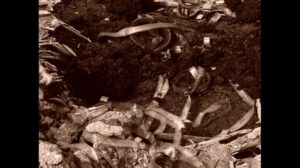Il Cinema Ritrovato: intervista al regista Bill Morrison

Dawson City: una remota cittadina alla confluenza fra i fiume Klondike e Yokon (Canada), che ha visto condensata in un brevissimo lasso di tempo la storia del mito americano della corsa all’oro, ma anche l’evoluzione dell’industria cinematografica. Dawson City come creatura in miniatura per capire due fenomeni tipici della modernità: il costituirsi, spesso violento e inesorabile, della società capitalistica, e il cinema come espressione del sentire moderno, in tutte le sue contraddizioni, materiali e non.
Il documentario diretto da Bill Morrison, distribuito quest’anno dalla Cineteca di Bologna e presentato in questi giorni al Cinema Ritrovato 2017, apre un ventaglio di riflessioni che spaziano in direzioni molteplici: la storia del luogo viene narrata mediante materiale d’archivio ma soprattutto attraverso l’uso narrativo di frammenti di film ritrovati fortuitamente proprio nella cittadina americana.
Centinaia di bobine, per lo più appartenenti a film muti compresi nei primi due decenni del Novecento, sono state ritrovate nella vecchia piscina di Dawson City, dopo un succedersi di eventi: l’espansione della città da un piccolo accampamento indigeno grazie al ritrovamento di numerosi giacimenti auriferi; l’avvento di una società dell’intrattenimento fatta di cinema ma anche di sale da gioco e bordelli; il declino progressivo, costellato anche da una serie di incendi tragici che coinvolgono soprattutto i cinema della città (le pellicole al nitrato erano altamente infiammabili).
Il documentario Dawson City si muove come in un prisma attraverso le vicende che definirono l’origine della civiltà nord americana. Si tratta di diverse storie che si intrecciano secondo modalità fluide, orchestrate da un montaggio che non sempre deve giustificare le proprie scelte. Troviamo la violenza insita nel capitale (espliciti i riferimenti a Trump, Rockefeller, alle deportazioni di anarchici e sindacalisti), ma anche l’evocazione visiva dell’informale e la riflessione sul deteriorarsi del corpo (dell’uomo e del cinema).
È con una modalità archeologica, in cui cerca di coinvolgere attivamente lo spettatore, che il regista Bill Morrison organizza il materiale, come a voler riprodurre e riordinare nel susseguirsi delle parti la casualità con cui una serie di oggetti viene trovata scavando nel suolo.
Il regista non impiega alcun tipo di retorica: è con la semplicità con cui gli eventi si manifestano che si intuisce come la storia di Dawson City – e del capitalismo – non sempre abbia brillato, per così dire, di eventi luminosi. È una narrazione con passaggi forti, a cui Bill Morrison non intende attribuire giudizio: tutto si dà nella naturalezza con cui si dà la Storia. E in questo scenario è come se le pellicole rinvenute e salvate da distruzione certa abbiano il potere di liberare un luogo ed il proprio passato.
Abbiamo letto che hai iniziato la tua carriera come artista visivo. Puoi dirci come questo aspetto abbia influenzato il tuo modo di valorizzare e giocare con le pellicole d’archivio impiegate in Dawson City?
In Dawson City il deterioramento provocato dall’acqua è qualcosa che ha caratterizzato immediatamente la collezione dei film fin dal momento in cui veniva scoperta: l’effetto dell’acqua ha infatti segnato ogni pellicola in modo diverso, e questo per me è stato molto interessante. Direi che in generale nel mio lavoro – come dicevate, mi sono affacciato al cinema da artista visivo, da pittore – mi sono sempre rivolto alla pellicola considerandola uno strumento plastico, come qualcosa che può interagire con il mondo. Dunque non si tratta solo di un materiale cristallizzato in scatole nere o file digitali, ma è qualcosa che può vivere e deteriorarsi, proprio come tutti noi.
Per quel che riguarda Dawson City, sono stato attratto da questa collezione perché è sopravvissuta a lungo, seppellita in una piscina: difficilmente esiste una storia più incredibile di questa. Prima ancora di vederle, ho immaginato che queste pellicole fossero deteriorate: e lo sono, ma in un modo del tutto differente rispetto a quello che immaginavo. Il tipo di usura è quasi del tutto accidentale, infatti non penetra dentro l’immagine come accade invece per il nitrato d’argento (dove le pellicole sembrano quasi fondersi): i supporti paiono cambiare forma e il movimento muta direzione. Nei film di Dawson è visibile un effetto particolare, un tremolio bianco che si situa sulla superficie della pellicola e che nel mondo dell’archivistica è stato definito Dawson flutter. È immediatamente riconoscibile – non ha nulla a che vedere con il deterioramento da nitrato d’argento – ed è una caratteristica che appartiene a tutta la collezione, rendendola unica.
Mi sono avvicinato all’intera collezione con l’idea che le pellicole ritrovate nella piscina comunale di Dawson City potessero raccontare la storia di come fossero arrivate lì. Questo è anche legato ai miei esordi come artista visivo – per me è importante che il contenuto rifletta il supporto del quadro: sono molto affascinato da questo modo di lavorare con il video. Dunque, è stata una sorta di intuizione, non sapevo in quali condizioni fossero le pellicole ma poi ho osservato che c’era questo deterioramento, queste macchie di colore date dall’acqua: hanno una bellezza particolare e si trovano proprio sulla superficie, e non dietro o dentro l’immagine. Alle volte rappresentano il fuoco, come nella ripresa di Edison, che culmina in una deflagrazione: le ultime immagini del film, con questa danzatrice che sembra fuggire dal fuoco.
Sì, in effetti volevamo chiederti proprio della “salamandra”, questa figura mitica evocata dal film di Edison, che sembra danzare attraverso il fuoco senza essere danneggiata. In generale abbiamo osservato che nel tuo lavoro esiste un dialogo intimo tra gli elementi. C’è qualcosa di estremamente affascinante nel modo in cui metti in connessione materiali artificiali ed elementi naturali. Ci chiedevamo se avevi considerato una certa sensibilità delle pellicole, che ricordano con i loro diversi gradi di deterioramento l’informale pittorico.
Si, le differenti trame di questi frammenti d’archivio rivelano la narrazione principale del mio documentario in modi a volte sorprendenti ed inaspettati, in questo caso facendo a meno dell’elemento formale e utilizzando la narrazione di queste pellicole. Ed è questo il dispositivo di base per raccontare la storia. Lo spettatore viene informato attraverso varie modalità del fatto che si tratta di frammenti diversi e non di una narrazione unica: c’è un titolo in ogni clip che indica la fonte – se provengono dalla piscina comunale di Dawson City (Dawson City Film Find) o se si tratta di altro materiale d’archivio. Questo espediente trasmette l’idea di quale fosse la relazione iniziale fra i vari materiali, ma anche che le due modalità sono connesse le une con le altre – si è consapevoli del fatto che si stanno vedendo scene separate, eppure c’è anche l’impressione di trovarsi di fronte ad una sequenza continua.
In modo simile ha lavorato anche il sound designer, John Somers: attraverso un programma specifico è stato in grado di ascoltare il rumore visivo del Dawson flutter (gli effetti di deterioramento dell’acqua sulla pellicola), riuscendo a creare non solo un sound design ma anche un noise design. È un rumore che deriva direttamente dalle informazioni visive, in modo che ogni clip abbia una traccia audio differente, dando la sensazione di guardare un accumulo di scene. Credo che questo sia un importante messaggio sotteraneo nel film.
Ci sono molteplici livelli nascosti sotto la superficie del film. Ad esempio, in che modo credi che il tuo lavoro si relazioni con il quadro politico attuale? Sono presenti numerosi riferimenti in tal senso.
Dawson City è un caso davvero interessante, perché è un esempio di storia compressa. Per gli europei l’intera storia americana risulta indubbiamente condensata e molto giovane, ma Dawson City porta questa idea a un livello ulteriore. È esistita come accampamento di una popolazione indigena fino alle soglie del ventesimo secolo: a questo punto è stato quasi inevitabile che la tecnologia e la crescita la raggiungessero. Tutto questo accade in tempi rapidissimi per la presenza dell’oro. Nel giro di pochissimo tempo Dawson City si trasforma da insediamento incentrato sulla caccia e la pesca a cittadina del west ben strutturata e davvero stravagante, dove era possibile trovare caviale e champagne, ma anche gioco d’azzardo e la prostituzione.
Sia l’ascesa che il declino di questa città avvengono in modo molto rapido. A partire dal 1889, Dawson City è divenuta una città mineraria molto redditizia, in grado di dare lavoro a diecimila persone. Nel momento in cui molti più investimenti sono stati coinvolti, l’estrazione dell’oro è stata progressivamente privatizzata e meccanizzata, a scapito della forza lavoro. Così, nell’arco di circa dodici anni si assiste al passaggio da accampamento indiano a depressa cittadina del Mid-West, in cui le industrie arrivano e sventrano la forza lavoro. Questa storia così compressa rappresenta una metafora di quello che sta accadendo nel mio paese e in molti altri paesi industrializzati. È un fenomeno comune, ed è in fondo la storia del capitalismo: può solo crescere ancora e ancora, prima di collassare. Credo che la più grande ironia, ben riportata nel documentario, sia la storia del nonno di Donald Trump, uno dei proprietari di bordelli che si approfittò di tutte quelle persone in cerca di ricchezza: ebbe l’intuizione di capire quanto profitto avrebbe portato dare ristoro a questi uomini alla ricerca del santo graal.
Ed è un po’ la stessa dinamica con suo nipote, che trae profitto illudendo le persone che aspirano a diventare ricche.
Stavamo riflettendo sul processo di lavorazione del materiale d’archivio di Dawson City, e su come esso si riflette nel montaggio, nella struttura filmica e nella musica. Tutti questi livelli creano una profondità che ci ha sorpreso. Si tratta di un uso meta-riflessivo delle immagini ricavate dai film muti per commentare o per rappresentare la storia di Dawson City. Questo ci è sembrato davvero affascinante e a suo modo post-moderno.
Non c’era alcuna immagine di Dawson City all’interno delle pellicole congelate, che hanno costituito dunque un materiale di supporto, attraverso cui raccontare delle storie a partire da una ricerca di parole chiave: quando “film”, “oro”, “piscina” risultavano nel database, allora si trattava di materiale che poteva interessarmi.
Ma la vera fortuna, oltre al materiale rimasto custodito nella piscina, è stato il fatto che Dawson City è una città incredibilmente ben rappresentata: è sempre stata innamorata della propria immagine, e mentre le pellicole crescevano, facendone un ritratto sempre più accurato – la corsa all’oro, quella sorta di infatuazione per il cosiddetto northern (nordico) – non utilizziamo più quell’espressione, parliamo ancora oggi di un western, ma fino agli anni Venti la parola era northern – quella era Dawson City. C’era un Canadian Mountie (guardia a cavallo), un orso e poi c’era una ragazza tosta ma dal cuore tenero che stava dietro ad un bancone del bar, un casinò dove si ballava. C’era una Dawson City impressa nella mente delle persone che ha influenzato un intero genere di film, Darkening Trail è uno di questi. Dunque quel luogo ha una vera storia sentimentale con se stesso e con il cinema, fino a riflettere quella stessa immagine che il cinema aveva creato a sua volta.
E poi c’era questa incredibile quantità di materiale amatoriale – City of Gold è un film fantastico che ritrae gli anni ’50, quando solo novecento persone erano rimaste a vivere in città, oppure i film amatoriali di George Black, che era un membro del parlamento. In generale, si riprendevano moltissimi film amatoriali in bobine da sessanta millimetri. Ed erano film che in un certo senso prevedevano il futuro, come ad esempio le riprese dei teatri in fiamme: è stato filmato l’Orpheum Theater durante l’incendio, e le persone capivano che era un simbolo della vecchia Dawson City e che una volta bruciato sarebbe giunta una nuova era.
Filmando l’Orpheum che bruciava e poi il nuovo Orpheum, diventato teatro moderno, c’era realmente la sensazione che queste persone stessero guardando il secolo andarsene.
Al momento del grande ritrovamento, le persone scattavano foto delle pellicole nel momento in cui spuntavano dal terreno: il popolo di Dawson comprese che si trattava di una capsula del tempo della città stessa e che tutto quello che vi è accaduto è in un certo senso la storia in miniatura del ventesimo secolo.
Laura Di Nicolantonio, Beatrice Seligardi e Margherita Caprilli










